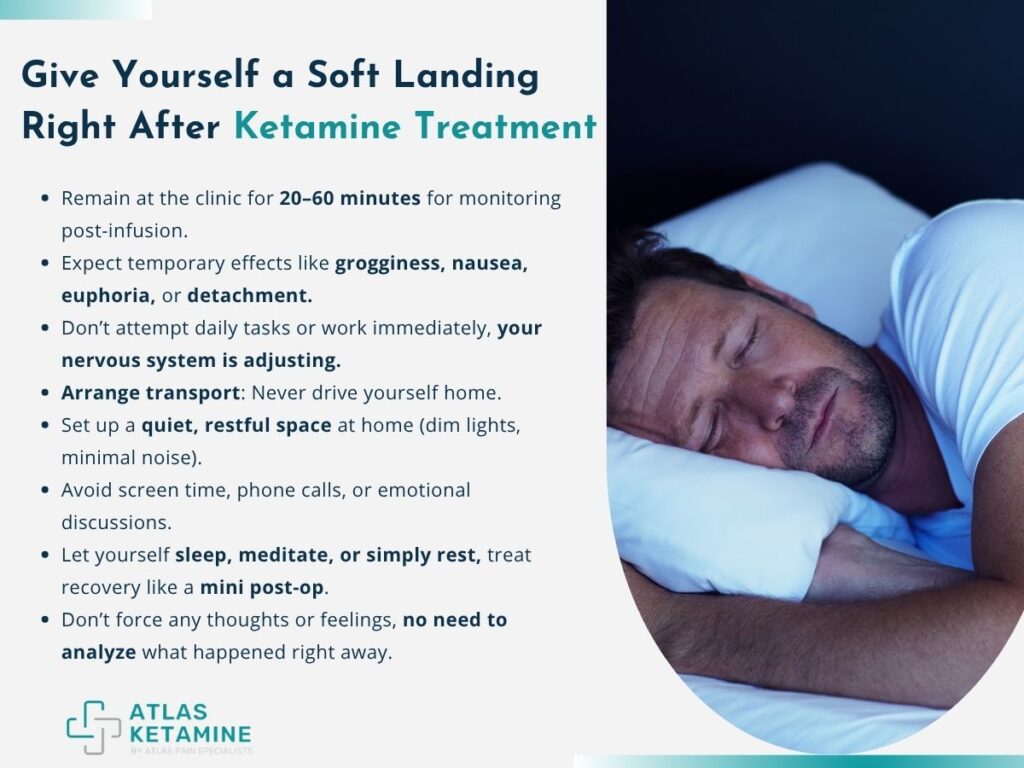The moments after a ketamine infusion can feel like floating between two worlds, one where pain or depression has weight, and another where something lighter begins to take shape. For many patients in the United States using ketamine therapy to treat conditions like treatment-resistant depression, chronic pain, or PTSD, the question becomes: what now?
The infusion is only part of the story. What to do after a ketamine infusion? What post-treatment care should you follow to support recovery, maximize benefits, and ensure long-term mental wellness
This blog explores real-world advice on what to expect and how to care for yourself after a ketamine infusion. It’s more than just rest and hydration. From how to manage emotional shifts to knowing when to call your doctor, we’ve broken it down for you here.
Give Yourself a Soft Landing Right After Treatment
The first few hours post-infusion matter more than most people realize. Once the infusion is complete, you’ll likely be monitored at the clinic for about 20 to 60 minutes.
That’s because ketamine can cause temporary changes in blood pressure, heart rate, and perception.You may feel groggy, mildly euphoric, emotionally detached, or even slightly nauseated. These symptoms usually fade within a few hours, but this isn’t the time to jump back into daily tasks.

- Arrange for Safe and Quiet Transport Home
As soon as your ketamine session ends, you’ll be monitored for 20 to 60 minutes. Even if you feel mentally alert, ketamine can temporarily impair your coordination and reaction time.
That’s why driving yourself home is not allowed. It’s important to arrange for a trusted friend, family member, or rideshare to take you home safely.
- Let Your Body and Mind Rest Fully
Post-infusion, you may feel emotionally detached, euphoric, tired, or even slightly nauseated. This is your nervous system recalibrating. Rather than jumping back into daily routines, plan to nap or spend time quietly in a calm environment.
Treat this window as mental and emotional recovery time, similar to how you’d treat post-op rest after surgery.
- Avoid Stimulants, Alcohol, and Stressful Interactions
The first 12 hours after your infusion are especially sensitive. Avoid alcohol, cannabis, or any other substances, as they may interfere with ketamine’s neurochemical processes.
| Symptom | What It Means | How to Manage |
|---|---|---|
| Grogginess / fatigue | Nervous system recalibrating | Rest in a quiet space, nap if needed |
| Mild euphoria / detachment | Normal neurochemical response | Allow feelings to pass, journal later |
| Nausea or dizziness | Temporary side effect of ketamine | Eat bland foods, hydrate slowly |
| Emotional sensitivity | Brain processing deeply | Avoid stressful conversations |
It’s also wise to steer clear of emotionally charged conversations or major decisions. Your mind may be more reactive or vulnerable than usual, and giving yourself space protects your healing.
- Eat Light if You Feel Nauseated
Your appetite might be off right after the session. If you’re feeling queasy, bland foods like bananas, crackers, rice, or toast can ease digestion.
Heavy or greasy meals are best avoided until your body signals it’s ready for more. Some patients describe the post-infusion window as feeling like they’re “hovering” mentally.
Giving yourself permission to just be without needing to explain or analyze anything can be incredibly helpful. Treat it like you would recovery, after surgery, your brain just did something important, and it deserves deliberate care.
Expect Emotional Ripples
Ketamine can stir deep emotions, sometimes days after treatment. Many people report a mood lift, improved clarity, or sudden shifts in their perception of trauma or stress.
Others experience a sense of melancholy, sensitivity, or emotional openness. These reactions are all valid. Ketamine works partly by increasing glutamate activity, which impacts emotional memory processing. That’s a good thing but it can feel intense.
Common emotional responses include:
- A surprising burst of joy or connection
- Emotional sensitivity, including weeping or irritability
- Old memories resurfacing vividly
- A desire to isolate or retreat briefly
Some patients find that these feelings lead to long-overdue insights, while others simply acknowledge them and move on. If you’re in therapy, this is a great time to bring up whatever is surfacing.
It’s also perfectly okay to feel “nothing.” Sometimes the benefits build gradually and subtly.
In fact, some of the most effective treatments feel uneventful in the moment but reveal their impact in the days that follow. Emotional flattening or a sense of neutrality may actually signal that your nervous system is stabilizing.
Hydration, Nutrition, and Sleep Are Your Recovery Tools
Your body needs support to process the changes ketamine triggers. Ketamine doesn’t just affect the brain. It has systemic impacts on energy levels, digestion, and sleep.
| Avoid | Why | Safer Alternative |
|---|---|---|
| Driving yourself | Coordination/reaction time impaired | Arrange for pickup or rideshare |
| Alcohol / cannabis / stimulants | Interfere with ketamine’s effects | Water, herbal tea |
| Heavy meals | Can worsen nausea | Toast, bananas, rice |
| Stressful interactions | Mind is more reactive | Calm, supportive environment |
After the infusion, your body may feel oddly tired or achy, and your appetite might be unpredictable. This is temporary, but it’s your signal to care for yourself deliberately.
- Hydration Helps Your System Reset
After a ketamine infusion, staying hydrated is essential. Ketamine can cause mild dehydration or dizziness as it metabolizes.
Drinking water or herbal teas not only helps flush out metabolites but also supports overall brain and body function. It's best to avoid caffeine or sugary drinks immediately afterward, as they may contribute to fatigue or irritability.

- Nourishing Meals Support Brain Recovery
Your body may feel fatigued, and your appetite could fluctuate, but feeding your system with nutrient-rich foods can make a difference. Meals that include lean proteins, leafy greens, whole grains, and healthy fats like nuts or avocado can help replenish your energy and stabilize your mood.
Avoiding processed sugars and heavy carbohydrates will help you maintain steady energy levels during the recovery period.

- Restful Sleep Amplifies the Benefits
Ketamine affects the nervous system, which may disrupt or enhance sleep depending on your personal chemistry. Prioritizing sleep in the 24 to 48 hours post-infusion helps consolidate emotional and cognitive changes triggered by the treatment.
Creating a calming bedtime routine like a warm bath, soft music, or light stretching can support deeper, more restorative sleep. Avoid screen time and stimulants to ensure your mind and body get the full rest they need..
You don’t need to overhaul your lifestyle overnight, but being intentional with food, hydration, and rest can ease side effects and enhance results. Patients with chronic pain may find that ketamine’s effects on physical symptoms take longer to interpret. Stay gentle with yourself as you assess those changes over several days.

Let the Medicine Work by Doing Less, Not More
Integration is where the healing happens. What you do after the infusion session is just as critical as what happened in the clinic chair. The brain enters a flexible, receptive state that lasts for 24 to 72 hours.
During this window, many people experience heightened creativity, introspection, or insight. The goal is to integrate that shift so it becomes part of your everyday mental framework.
According to the American Journal of Psychiatry (2021), ketamine may temporarily reduce activity in the default mode network, a region of the brain involved in negative self-referential thought patterns.
This reduction allows patients to experience new ways of thinking, especially about themselves and the world.
| Practice | Why It Helps | Example |
|---|---|---|
| Journaling | Captures insights and emotions | Write within 6 hours |
| Gentle hobbies | Encourages reflection | Drawing, cooking, nature walk |
| Media hygiene | Avoid overstimulation | Skip violent or chaotic shows |
| Intention-setting | Anchors experience | “Stay present” or “hydrate well” |
| Therapy support | Deepens processing | Discuss resurfacing emotions |
Tips for integration:
- Journal within 6 hours of your session. Capture your thoughts and emotions, even if they seem disjointed.
- Avoid watching disturbing or chaotic media. Your mind is highly open; what you absorb matters.
- Engage in a quiet hobby. Drawing, cooking, or walking outdoors can all support reflective processing.
- Set an intention for the next day. Something small like “stay present” or “drink water” helps you anchor the experience.
- Speak with a therapist or coach. Especially one familiar with ketamine-assisted therapy, if possible.
Doing less can actually help you gain more from the session. Give your psyche time to catch up with the shift.
Know When to Seek Medical Advice
Most side effects fade quickly, but some signs need attention. While ketamine has an excellent safety record in clinical settings, complications can happen especially if you’re new to the treatment or have certain underlying conditions.
It’s essential to distinguish between common post-infusion experiences and those that require medical attention.
- Mild Symptoms Can Be Managed at Home
After a ketamine infusion, some physical or emotional symptoms are expected and typically resolve on their own. You might experience lightheadedness, mild nausea, tiredness, or shifts in concentration.
Emotional fluctuations such as increased sensitivity or mood swings can also occur as part of the integration process. These are usually manageable at home with rest, hydration, and emotional support.
- Red Flags That Need Medical Attention
While most post-infusion experiences are benign, there are certain warning signs you shouldn’t ignore. If you begin to feel chest tightness, persistent confusion, or difficulty breathing, it’s important to contact your healthcare provider immediately.
Similarly, hallucinations that persist more than 24 hours or the return of suicidal thoughts are considered serious and require prompt evaluation.
- Your Clinic Should Be Part of Your Safety Net
Ketamine treatment should always be part of a structured and monitored care plan. If you’re uncertain about any symptom whether physical or psychological, reach out to your clinic.
Most facilities have a nurse or physician on call for post-treatment questions. Trust your instincts; it’s better to seek clarity than to dismiss a potentially serious issue.
Ketamine should never be used alone without a structured treatment plan. If you ever feel unsure about your response, your clinic should have a nurse or doctor on call to assist. Trust your instincts especially if something feels off.
Plan for the Next Step in Your Treatment Journey
Post-infusion care isn’t just about what happens after one session, it's about the full arc of healing. Ketamine therapy is often delivered in a series of 4 to 6 initial infusions over several weeks, followed by booster sessions every few months if needed.
The benefit tends to build cumulatively, meaning that each session lays the groundwork for the next.
- Ketamine Treatment Is a Journey
One infusion can bring relief, but long-term benefits usually come from a full treatment series, typically 4 to 6 sessions spread over a few weeks. Some patients may need booster infusions every few months. The effects are cumulative, building over time.
- Create a Personal Ritual
After each session, develop a simple routine to help anchor the experience. Lighting a candle, journaling, or taking a warm shower can help you mentally transition and support emotional processing.
- Track Your Progress
Monitoring your symptoms, mood, sleep, energy, and focus helps both you and your provider. Use a journal or tracking app to notice patterns and assess your response to treatment.
- Involve Trusted Support
Let someone close to you know what you’re experiencing. A friend, partner, or therapist can help you stay grounded and offer encouragement if you feel emotionally unsettled.
- Stay in Communication With Your Provider
Always keep your care team informed. Share anything that feels off, even small details. This helps them personalize your treatment and ensures your safety throughout the process.
Are you seeking symptom relief, emotional insight, or both? Checking in with your purpose can help guide your next steps.
Conclusion
The time after a ketamine infusion is not just recovery, it's an opportunity. It's your mind opening the door to something new. By approaching post-treatment care with softness, patience, and support, you're giving that new version of yourself a chance to grow.
What you do after a ketamine infusion matters just as much as what happens during it. Rest, reflect, hydrate, and surround yourself with people or practices that support the deeper work. You don’t have to rush anything. Healing isn’t a race, it's a rhythm. And now, you’re in it.
